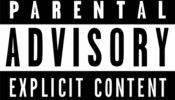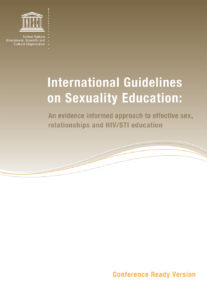
UNESCO Guidelines (2009)

Note: The International Guidelines on Sexuality Education were revised and updated in 2018 and published as the International Technical Guidance on Sexuality Education. See the analysis of the revised Guidance here.
The International Guidelines on Sexuality Education was published by the United Nations Educational, Scientific and Cultural Organization (UNESCO) in collaboration with other UN agencies including UNICEF, the United Nations Population Fund (UNFPA), and the World Health Organization (WHO). SIECUS and IPPF are mentioned multiple times. These guidelines maintain that children have a right to receive instruction in sexual pleasure, masturbation and homosexuality, among other things. Nanette Ecker, Director of International Education and Training at the Sexuality Information and Education Council of the United States (SIECUS), was one of the main authors.
TARGET AGE GROUP: 5 – 15 Years
Examples of Harmful Content
The following are excerpts from some of the “Learning Objectives” in the Guidelines:
Learning Objectives for Level I (ages 5-8)
“Girls and boys have private body parts that can feel pleasurable when touched by oneself.” (p. 43)
“It is natural to explore and touch parts of one’s own body.” (p. 48)
“Bodies can feel good when touched.” (p. 48)
“Touching and rubbing one’s genitals is called masturbation.” (p. 48)
“Masturbation is not harmful, but should be done in private.” (p. 48)
“People receive messages about sex, gender, and sexuality from their cultures and religions.” (p. 39)
“All people regardless of their health status, religion, origin, race or sexual status can raise a child and give it the love it deserves.” (p. 51)
Learning Objectives for Level II (ages 9-12)
“Both men and women can give and receive sexual pleasure.” (p. 43)
“Relationship between excitement and vaginal lubrication, penile erection and ejaculation.” (p. 44)
“Many boys and girls begin to masturbate during puberty.” (p. 44)
“Steps for proper use of condoms.” (p. 51)
“Definition and function of orgasm.” (p. 49)
“Legal abortion performed under sterile conditions by medically trained personnel is safe.” (p. 51)
Learning Objectives for Level III (ages 12-15)
“Respect for the different sexual orientations and gender identity.” (p. 48)
“Both men and women can give and receive sexual pleasure with a partner of the same or opposite sex.” (p. 50)
“Everyone is responsible for their own and their partner‟s sexual pleasure and can learn to communicate their likes and dislikes.” (p. 50)
“Access to safe abortion and post-abortion care.” (p. 52)
“The size and shape of [genitals and other body parts] vary and do not affect reproduction or the ability to be a good sexual partner.” (p. 46)
Definition and description of the physical changes and stages of male and female human sexual response including orgasm. (p. 50)
According to the Guidelines, by age 15, adolescents should be exposed to “advocacy to promote the right to and access to safe abortion.”
The concept of abstinence is mentioned as “only one of a range of choices available to young people.” The Guidelines describe abstinence-only programs as “fear-based” and “designed to control young people’s sexual behavior by instilling fear, shame, and guilt.”
Evidence of Failure
There is no evidence that the philosophies, practices and teaching objectives promoted in the 2009 “International Guidelines on Sexuality Education” are effective for reducing risky sexual behavior among young people.
A common tactic used by comprehensive sex education (CSE) advocates is to claim their programs are “evidence-based,” asserting they are backed by studies that prove their effectiveness for young people. However, the research does not support this view, according to a recent in-depth review of some of the strongest and most current studies of CSE in school settings. (See SexEdReport.org.) This extensive analysis reviewed 60 studies of 40 school-based CSE programs in the United States and 43 studies of 39 school-based CSE programs used outside of the U.S. (all studies were previously vetted for research quality by HHS, the CDC, or UNESCO.)
Applying meaningful and recommended standards to assess program effects on increased teen abstinence and/or condom use and decreased teen pregnancy or STDs, the researchers found little evidence of real effectiveness for school-based CSE and a concerning number of harmful effects. Out of the 103 studies, only 10 showed improvement on a key protective indicator one year after the program, for the intended population, without other negative effects. Yet, 15 of these studies found school-based CSE programs had a harmful impact – by increasing teens’ sexual risk behavior and/or reducing their sexual health.


